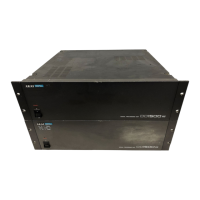CONNECTIONS - SYSTEM - 4
Version 2.00 - March, 1996 Page 23
To get audio to the DL1500 for monitoring (and maybe simple mixdown), connect the
DIGITAL AUDIO OUT 9-pin D-Sub connections on both units using the cable provided.
Connect a standard S-VGA colour monitor’s cable to the DL1500’s DISPLAY output
(standard S-VGA 15-pin D-Sub).
The DD1500x disk drive is connected to the DD1500m using SCSI.
The VTR is connected using RS422. The DL1500 can be used to play, stop, rewind, fast
forward and jog the picture. The DD1500m must receive a timecode feedback from the
VTR (i.e. the RS422 tells the VTR what to do, the timecode back to the DD1500 tells the
DD1500m the timecode position the VTR is at). This timecode can be derived from a
number of sources. At its simplest, it could be just timecode recorded on the audio tracks
of the video tape derived from the VTR’s audio outputs. It could be derived from the
TIMECODE output found on most professional RS422 equipped VTRs. Alternatively, you
could use VITC instead of LTC and this would be derived from the VTR’s VIDEO out as it
is embedded in the picture itself. You should decide which is best for your circumstances
and the equipment you are using.
It is recommended to sync the whole system to a common house sync source so that the
whole system - the video, timecode and DD1500’s audio - is properly and precisely
synchronised to prevent any drift. This would normally be connected to the WORDCK
(A)/VIDEO SYNC (A) BNC connection on the DD1500m and the sync type selected from
the DL1500.

